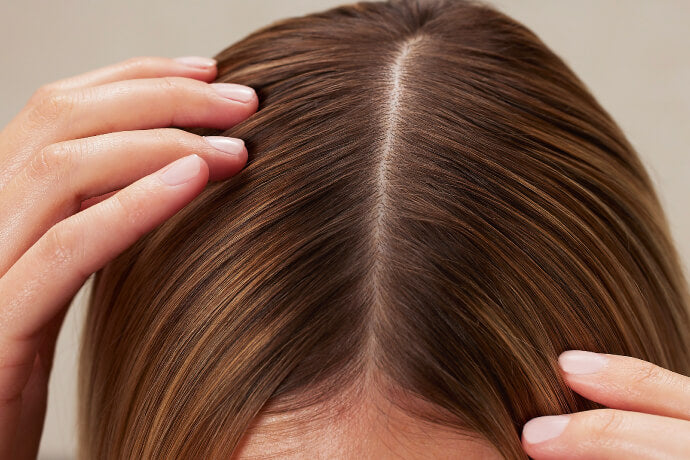When we care for plants, we water the soil and we add fertilizer to make sure that the plant has everything it needs to feed its roots and stay nourished. Scalp care is the same way. To ensure that hair is healthy, we must start with the soil, or the scalp. We can care for our hair from the inside by eating good-for-you foods and managing stress, and we can care for our scalp by increasing circulation, adding hydration and keeping it free of buildup and irritation.
If your hair has been looking lackluster, feeling dry or not growing, it's important to look at your complete routine. Do you massage your scalp consistently? What does your nutrition look like, and are you missing any key parts of your diet? Are you stressed, and how does that manifest in your day to day? What is your cleansing and styling routine? To better understand the inner workings of your scalp, we created a guide that breaks down what it is and why it's so necessary to nourish it:
What Is the Scalp?
It's the soft tissue that covers the head, located behind the face and above the neck and ears. Aesthetically, it serves as an area where hair grows and physically, as a barrier that defends the body from foreign irritation. The scalp also helps repair your skin after a wound or injury (follicle cells go to the wound site).
Understanding the Scalp
Hair Strand - hard protein, keratin, what you see coming out of the scalp
Sebaceous Glands - glands connected to the follicle providing lubricant and oil to condition hair
Hair Root - inner part of the hair strand, embedded in the follicle
Dermal Papilla - feeds and creates the start of the hair strand (root) from blood vessels
Nerve - wrapped around each hair follicle, creates sensation when hair moves
Blood Vessels - coming from our arteries, these bring blood flow and nutrients to the hair follicle
Follicle - the opening from which the hair strand grows from, and is an organ!
How It Works
Blood flow brings nutrients to the scalp, which will feed each hair follicle. Good nutrition and blood flow is very important to ensure that the hair follicle gets the proper building blocks of the hair shaft. Living cells divide and grow to build the hair shaft from keratin protein.
Anagen - growing phase, 2-7 years
Catagen - resting phase, 2 weeks
Telogen - falling out phase, 4 months
*Stress, hormones, illness, medication can impact all these phases.
Scalp can more easily absorb than other areas of the body. (studies vary on the actual amount)
Why It's Important for Healthy Hair
If the hair follicle is healthy and nourished, it can grow hair faster and healthier. If the follicle is unhealthy it can cause a shortened growing phase, or weaker hair. Examples of this can be clogged hair follicles from buildup, improper cleansing or inflammation.
"Oxidative stress and inflammation in the scalp have a well documented impact on the quality of hair. When scalp health suffers, hair strands are prone to alterations in surface texture and biochemical composition, which may manifest as breakage and dullness. Maintaining a healthy scalp is crucial to optimizing hair growth, texture, and even to minimize the effects of some of the causes of premature hair loss."
-Rebecca Marcus, MD is a board-certified dermatologist and founder of Maei MD: science-backed skincare that delivers superior results via a streamlined, sustainable, single-step serum.
Feeling Inspired?
Our new Harmonic Hair Renew 3-piece set gets to the root of your concerns by bringing the scalp back into perfect harmony for healthier, more resilient hair.


